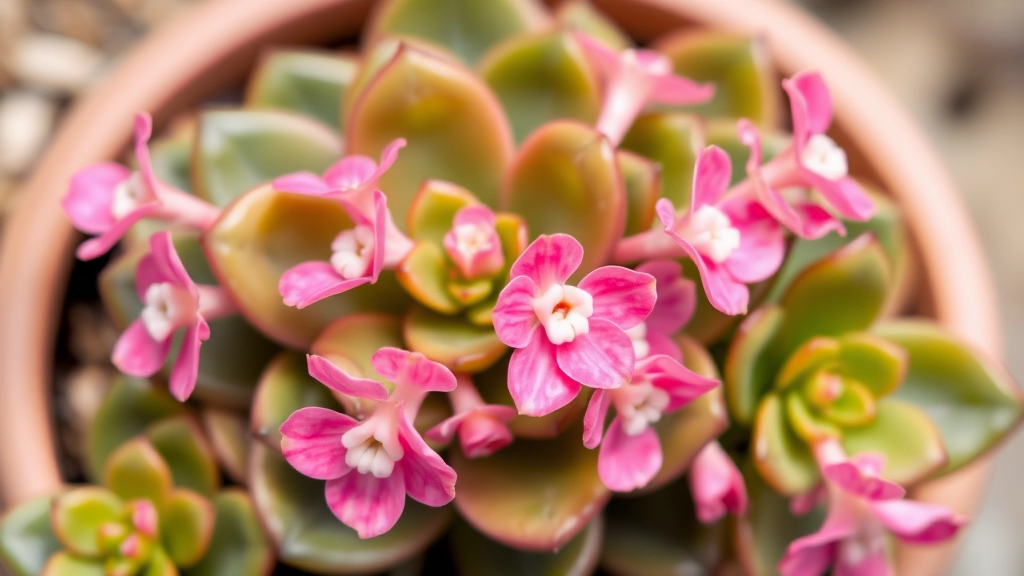Welcome to the vibrant world of kalanchoe succulents with pink flowers!
In this article, we’ll explore these charming plants that combine resilience with beauty. From popular varieties like the classic Kalanchoe blossfeldiana to the stunning ‘Pink Butterflies’, we’ll dive into what makes these succulents a favorite among plant enthusiasts and how to care for them properly.
Whether you’re a seasoned plant parent or a beginner looking for a low-maintenance addition to your collection, kalanchoe succulents with pink flowers offer the perfect blend of ease and elegance. We’ll cover everything from light and water requirements to seasonal care tips, ensuring your kalanchoe thrives year-round. Get ready to fall in love with these pink-flowered beauties!
Popular Kalanchoe Varieties with Pink Flowers
Alright, let’s dive into the world of pink kalanchoe succulents. These little beauties are like the rockstars of the succulent world – tough, pretty, and always ready to steal the show.
Ever seen a kalanchoe and thought, “Wow, that’s a looker”? You’re not alone.
Kalanchoe blossfeldiana is the classic crowd-pleaser. It’s like the friendly neighbour of succulents – always blooming and easy to get along with.
But have you met Kalanchoe ‘Pink Butterflies’? It’s the Instagram model of kalanchoes. Those pink-edged leaves are like nature’s own filter.
Here’s the deal with these pink wonders:
- They’re tough cookies. Drought? No problem.
- Low maintenance. Perfect for plant parents who forget to water.
- They bloom for ages. Like, seriously long.
How to Care for Kalanchoe Succulents
Caring for kalanchoes isn’t rocket science. Here’s the lowdown:
Light
These guys love the sun, but not too much. Think of them as sunbathers who forgot their sunscreen.
- Bright, indirect light is their sweet spot.
- A few hours of morning sun? Perfect.
- Afternoon sun? That’s a bit much. Shade them up.
Water
Kalanchoes are like camels. They store water and don’t need much.
- Let the soil dry out between waterings.
- In winter, cut back even more. They’re basically hibernating.
- Overwatering? That’s their kryptonite. Avoid at all costs.
Soil
Well-draining soil is key. Think sandy, gritty mix.
- Cactus potting mix works great.
- Or make your own: regular potting soil + perlite or sand.
Seasonal Care
Summer:
- More water, but don’t go crazy.
- Watch for sunburn on those hot days.
Winter:
- Less water. Way less.
- Keep them away from cold drafts. They’re not fans of the chill.
Remember, kalanchoes are like low-maintenance pets. They don’t need much, but they’ll thrive with a bit of love.
FAQs about Kalanchoe Succulents with Pink Flowers
Q: How often should I water my pink kalanchoe?
A: Water your pink kalanchoe only when the soil is completely dry. This usually means watering every 2-3 weeks, but it can vary depending on your environment. Remember, it’s better to underwater than overwater these succulents.
Q: Can I grow kalanchoe outdoors?
A: Yes, kalanchoes can be grown outdoors in USDA hardiness zones 10-12. If you live in a colder climate, you can move them outside during summer months but bring them in when temperatures drop below 50°F (10°C).
Q: Why are the leaves on my kalanchoe turning yellow?
A: Yellowing leaves often indicate overwatering. Reduce your watering frequency and ensure your pot has good drainage. If the problem persists, check for root rot and repot if necessary.
Q: How can I encourage more blooms on my pink kalanchoe?
A: To encourage blooming, provide your kalanchoe with 14 hours of complete darkness each night for about six weeks. This mimics the shorter days of fall and triggers blooming.
Q: Is Kalanchoe toxic to pets?
A: Yes, kalanchoe is toxic to cats and dogs if ingested. Keep these plants out of reach of your pets, or consider pet-safe alternatives if you have curious furry friends.
Q: How do I propagate my pink kalanchoe?
A: Kalanchoes are easy to propagate from leaf or stem cuttings. Allow the cutting to callus over for a few days, then plant it in well-draining soil. Keep the soil slightly moist until roots develop.

